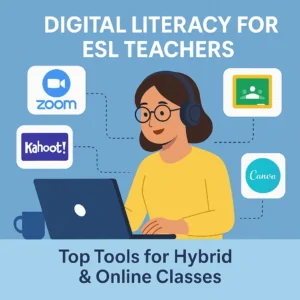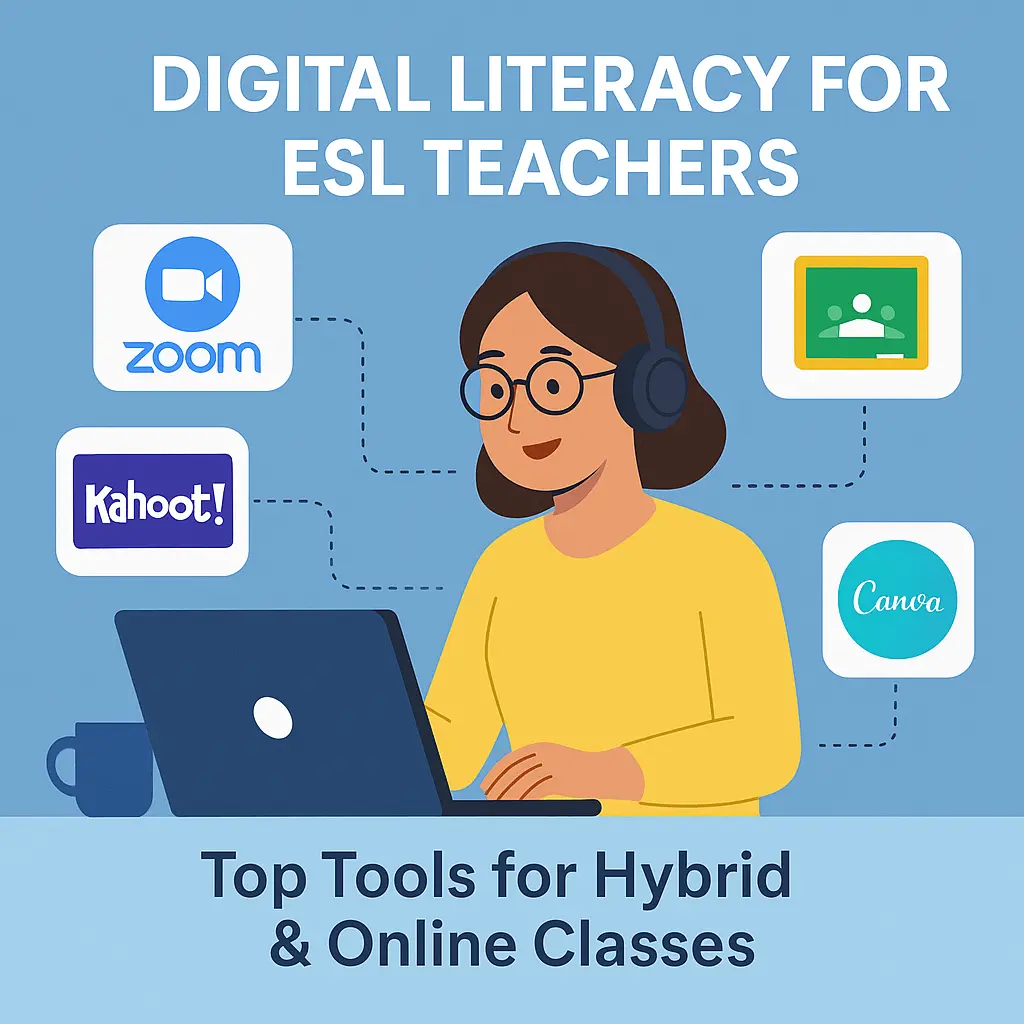Digital Literacy for ESL Teachers
By 2025, a large number of ESL instructors will be instructing in hybrid classrooms and online. This implies that educators need to be proficient in integrating technology into their lessons. We refer to this as digital literacy. It assists teachers in improving their instruction, building relationships with students, and utilizing resources that enhance learning. Digital Literacy for ESL Teachers
This blog will teach you:
- What ESL teachers should know about digital literacy
- Why it matters in 2025
- The best resources for your hybrid and online ESL classes
- Simple examples of how to use these tools
- Free tools and advice to improve your digital abilities
What Does Digital Literacy Mean for ESL Teachers?
The ability to teach and learn using computers, mobile devices, software, and the internet is known as digital literacy. Digital Literacy for ESL Teachers for English as a Second Language (ESL) teachers consists of:
- Taking live classes with Teams, Zoom, or Google Meet
- Using websites or apps to create interactive lessons
- Using online resources to share assignments and feedback
- assisting pupils in practicing their English using technology
Not only computer experts need to be digitally literate. Every ESL teacher can learn and use these tools—even beginners!
What Makes Digital Literacy Crucial in 2025?
ESL teachers today need to be digitally literate for the following five reasons:
1. A lot of classes are hybrid or online.
Online learning became commonplace following the COVID-19 pandemic. These days, a lot of students enroll from home or combine online and in-person courses. To reach everyone, you need tools.
2. Students Love Technology
Students take pleasure in using laptops, tablets, and smartphones. They remain engaged and engaged in learning when digital resources are used in the classroom.
3. Schools Want Teachers Who Know How to Use Technology
Teachers who are comfortable using digital tools are now preferred by schools and language centers. It demonstrates your adaptability and modernity.
4. Enhances Instruction & Conserves Time
You can more quickly plan lessons, grade student work, and provide immediate feedback with the aid of technological tools.
5. Having Access to Worldwide Resources
Technology allows you to access resources from around the globe, including websites, games, videos, and more.
The Best Digital Resources for ESL Teachers in 2025
These are the most effective and user-friendly resources available to ESL teachers today. We put them in groups according to our goals.

1. Tools for Video Conferences (For Live Online Classes)
Zoom
- The most widely used video app for online instruction
- Use breakout spaces, whiteboards, and a shared screen.
- For students who were absent from class, record the lessons.
Google Meet
- Google Classroom makes things simple for schools.
- Compatible with Google Docs and Slides
- Easy-to-use interface for educators and learners
2. Learning Management System (LMS) Tools
Google Classroom
- Free and easy for beginners to use
- Distribute announcements, grades, and homework.
- Utilizing other Google apps is simple.
👉Take a look at Google Classroom.
Canvas Learning Management System
- Common in academic institutions and language courses
- provides grading tools, video lessons, and quizzes.
- Excellent for a hybrid learning environment
4. Resources for Writing Exercises
Padlet
- Internet notice board
- Students create content, share images, and record videos.
- Excellent for group projects or creative writing
Grammarly
- aids pupils in becoming better writers
- Verifies sentence structure, grammar, and spelling
- ESL students benefit from the free version.
5. Practice Tools for Speaking and Listening
Flip, formerly known as Flipgrid
- Students record brief video answers.
- Practice speaking English with confidence
- Instructors can provide text or video feedback.
BBC Learning English
- Free lessons in speaking and listening
- contains news articles, videos, and tests.
- beneficial for ESL students at the intermediate and advanced levels
6. Presentation Tools
Canva for Learning
- Create infographics, digital posters, and lesson visuals.
- Drag-and-drop design, user-friendly
- Students are able to produce original visual projects.
- Make Use of Canva for Teaching
How to Utilize These Resources in an ESL Course
Let’s examine some instances from the actual world.
Example 1: Hybrid class vocabulary lesson
- Introduce new words with Quizlet.
- Make a Kahoot! review quiz
- Students compose sentences using new words using Padlet.
Example 2: Online Speaking Practice Course
- For a speaking lesson, use Zoom.
- Students use Flip to record their responses.
- Use text or emojis to provide feedback.
Example 3: Writing & Grammar
- To assist students in editing their work, use Grammarly.
- Post the task on Google Classroom.
- Use Canva to display the finished writing.
Strategies for Increasing Your Digital Literacy
- Get Started Small
Start with one or two tools. Try more after you feel at ease. - Become a Member of Teacher Communities
To gain knowledge from other educators, join forums or Facebook groups like TESOL International. - Watch Tutorials on YouTube
To find step-by-step videos, search for tool names plus “how to use.” - Enroll in Free Courses
Free digital skills courses are available on websites such as Coursera, edX, and Google for Education. - Consult Your Students
Students are frequently tech-savvy. Allow them to assist you or recommend tools that they find useful.
Concluding Remarks
Nowadays, being digitally literate is essential for ESL teachers; it is no longer a choice. With the right tools and support, you can create exciting, effective lessons that students love. These tools will improve your teaching and make your job easier whether you teach in-person, online, or both. Digital Literacy for ESL Teachers


